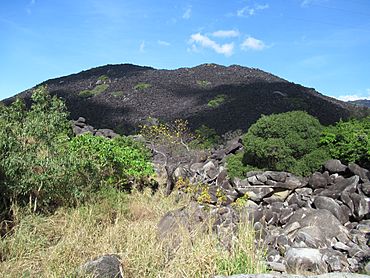Black Mountain (Kalkajaka) National Park facts for kids
Quick facts for kids Black Mountain (Kalkajaka)National Park Queensland |
|
|---|---|
|
IUCN Category II (National Park)
|
|

View of one of the black mountains from Mulligan Highway
|
|
| Nearest town or city | Cooktown |
| Established | 1980 (Register of the National Estate) |
| Area | 7.81 km2 (3.0 sq mi) |
| Managing authorities | Queensland Parks and Wildlife Service |
| Website | Black Mountain (Kalkajaka) National Park |
| See also | Protected areas of Queensland |
Black Mountain (Kalkajaka) National Park is a special protected area in Queensland, Australia. It covers about 781 hectares (that's about 1930 acres!). This park is famous for its huge piles of black granite boulders. Some of these rocks are as big as houses!
The park is about 25 kilometers (15 miles) southwest of Cooktown. It is looked after by the Queensland Parks and Wildlife Service.
Contents
What Makes Black Mountain Special?
The main thing you'll notice at Black Mountain National Park is the giant stacks of black rocks. These rocks are so close together that there's almost no soil between them. This creates a confusing maze of gaps and tunnels. You can even go inside the mountain through some of these passages. But be careful, these rocks can get super hot!
The area has some mysterious stories. People have gone missing here over the years. It's believed they might have fallen into the deep cracks or gotten lost in the rock maze.
How Black Mountain Was Formed
The hard black rocks of Black Mountain are made of a type of stone called granodiorite. This rock was formed from magma, which is melted rock deep inside the Earth. Millions of years ago, this magma slowly cooled down and became solid under the ground.
Over a very long time, the softer land above the solid rock wore away. This left the hard granite exposed as a mountain of grey boulders. These boulders look black because tiny blue-green algae grow on their surfaces. When cold rain falls on the hot rocks, it can make them crack and break apart. Sometimes, this even happens with a loud bang!
Cultural Stories of Kalkajaka
The "Black Mountains" are very important to the Kuku Nyungkal people, who are the traditional owners of this land. They call it Kalkajaka, which means "place of spear."
The Kuku Nyungkal people have many special stories about the mountain. They believe there are at least four important places on the mountain:
- Kambi: A large rock with a cave where flying-foxes live.
- Julbanu: A big rock shaped like a grey kangaroo, looking towards Cooktown.
- Birmba: A stone facing towards Helenvale, where you can see sulphur-crested cockatoos.
- Yirrmbal: A sacred place near the bottom of the mountain.
Even after European settlers arrived, new stories about the mountain began. People told tales of explorers, horses, and even groups of cattle disappearing into the maze of rocks, never to be seen again.
Unique Animals of Black Mountain
Black Mountain is at the very northern end of the Wet Tropics World Heritage Area. This means it's a special place where wet rainforests meet drier woodlands. It's like a natural hideout for animals that used to live in more places but are now only found here.
The unique environment of Black Mountain is the only place in the world where three special animals live:
- The Black Mountain boulderfrog (also called the rock haunting frog).
- The Black Mountain skink.
- The Black Mountain gecko.
This makes Black Mountain one of Australia's most important places for animals found nowhere else!
Visiting Black Mountain
If you want to visit Black Mountain National Park, there are a few things to know. You can't camp there, and there are no walking trails or picnic areas. However, there is a special viewing platform. Here, you can learn more about the park from helpful displays.
Gallery
See also
 In Spanish: Parque nacional Montaña Negra para niños
In Spanish: Parque nacional Montaña Negra para niños




